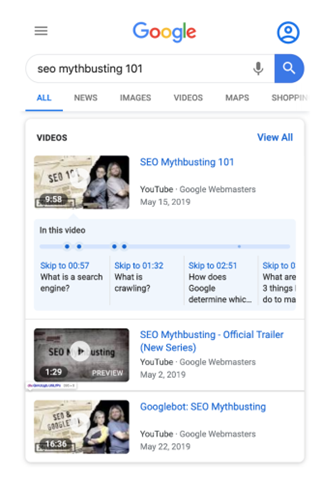SEO Guides, Tips & More!
Learn from Our Experience
New Google Resources for Video SEO
Video is here to stay … as if we didn’t already know better. It’s becoming the preferred medium for engaging with content online. All the major social media channels have a live video component, and of course, there’s TikTok. Videos are so popular that most people now want to see more of them from brands – and brands are complying.
Accounting firms, for their part, can use video for everything from the basic firm greeting to industry overviews and practice spotlights, team member profiles, culture spotlights, training, tax return recaps, and pretty much anything else creative marketers and willing accounting firms come up with.
Thanks to Google’s near-constant stream of updates, marketers who use video can see better search indexing and optimization. Video SEO is here.
First, the basics.
What is Video SEO?
Video SEO, like its traditional counterpart, is a means of optimizing video content so more eyeballs see it when they search for similar keywords and phrases. Marketers should know that videos are indexed differently on Google than in YouTube and keyword research needs to be done for both. As Semrush pointed out, it’s different search intent. You can read more on that here.
The problem is that most marketers aren’t paying enough or any attention to optimizing their videos for SEO. As with any marketing endeavor, start with the goals: what should the video accomplish? How does it serve the larger marketing plan?
Videos will generally have one of two goals: either to increase conversions or direct traffic back to the website. Keep in mind that brand awareness is pretty similar to generating web traffic – and when it’s time to explain marketing impact and ROI to the partners, one of these goals is easy to track and measure, and the other isn’t. Choose wisely.
So, is it better to host videos on YouTube or the website itself? That all depends. Once a video is indexed on YouTube, most users won’t visit the website directly from there and web traffic might not live up to expectations. In that case, a firm might be better off using alternative video hosting platforms so viewers are already on the website.
Next, the crux of video SEO.
Video SEO Best Practices
It’s helpful for marketers to first understand how Google finds and indexes videos. It identifies videos on webpages using signals like webpage data – think video HTML tags – and separate data – like sitemaps. Google has to understand what the video is about, so web developers and marketers must submit additional information besides just uploading a video and moving on with their day. Additional information that Google uses to understand video content and intent includes but is not limited to titles, captions, and referral links from other websites.
When a video is indexed and appears in search results, it can appear in one of three places: the Videos search tab, Images, or the Discover tab.

Source: Google
To get the best search results, start with a high-quality video that’s easy to see and hear and offers helpful, relevant information. From there …
- Design and upload an eye-catching video thumbnail. The thumbnail should clearly display what the video is about. Beware not uploading a specific thumbnail; Google can pull its own from a random frame that might not be the most aesthetically pleasing.
- The YouTube Studio app can help with video thumbnails.
- Write an engaging, relevant title tag that matches the desired search intent. This is where well-placed keywords go.
- Include a video description that describes the video. For YouTube, make sure there are different calls to action here, like the Subscribe button and a full URL.
- Input the right video tags. Video tags not only match the video to search intent but also help the video appear in related searches or the Discover tab based on user browsing history and related searches. To tag a video, select CONTENT from the YouTube Studio, then add the tags.
- Publish the transcript along with the video. It’s user-friendly, the page is crawled, and viewers can easily browse through to different sections to find the content that’s most appealing to them.

Good vs. Bad thumbnails from WordStream
For marketers who will do nothing else to optimize their videos, the last tip is where to focus one’s time. Always publish the transcript. Don’t worry – the video isn’t being ‘given away for free.’
Last but not least, more advanced tips.
Technical Details for Video SEO
In addition to the general best practices we mentioned above, there are a few technical ways to optimize videos. Some web-savvy marketers can do these steps themselves; for guidance, send us a message.
- Make sure the video isn’t blocked by a robots.txt or noindex metadata. Either one will render the video useless from an SEO perspective because it will appear as if the video is not on a public webpage.
- If the video is part of an app, make sure it’s also part of a corresponding webpage and is easily visible. Don’t make users jump through hoops to view it.
- Look at Google’s video structured data documentation for guidelines on how to mark up the video with appropriate structured data. Go to org and search for VideoObject markup. This data will include elements like the video title, schema markup, and more. The result is a video with a Google-approved badge and key moments enabled; or in other words, better search visibility.
- Before publishing the video, confirm the thumbnail image is high quality. Even if a thumbnail is specified, if it’s low-quality or blocked, Google won’t pick it up.
- Supported file formats include BMP, GIF, JPEG, PNG, WebP, and SVG.
- Submit a video sitemap to Google. Their instructions are available
- Make it easy for Google to fetch video files by enabling features like video previews and key moments.
- Ensure the video format is supported and Google can easily access audio and visual elements.

An image depicting video key moments from Google
While it’s true that even successful, viral videos can be shot with any smartphone, it’s the extra work in the back end that can really help increase the video’s searchability and relevance. On the surface, it might seem like all someone has to do is upload a video and click Publish, in reality, the most effective marketing and SEO strategies go a lot deeper than that.
Optimizing videos is one of the ways we can help accounting and other companies increase their online visibility. We’re here to answer your questions on video SEO – contact us anytime.

